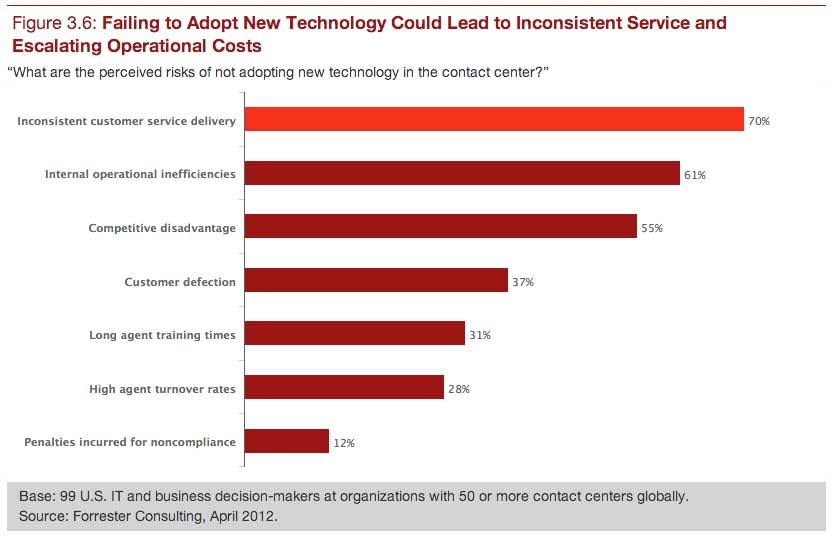
Customer Experience Index ratings reflect the ease, usefulness, and enjoyment of doing business with a company. However, Forrester Research reported in 2012 that only 37 percent of companies earned an “excellent” or “good” rating and nearly two-thirds were ranked as merely “ok” or “very poor.”
Technology plays several key roles during the customer journey. It facilitates “any time, any media” interactions such as voice, self-service, Web chats, and more. Social media and mobile innovations also bring new opportunities to better serve customers in their preferred environment. Big data and analytics offer actionable insights, allowing organizations to improve the customer experience on a real-time basis.
At the same time, technology can also interfere. Bad experiences can be amplified using social media, and a mishmash of outdated stand-alone systems and multiple repositories make it difficult for agents to respond to customer needs. The wrong technology choices—such as using multiple stand-alone platforms to store customer details, product information, history of past interactions, current and past orders, shipping, and billing—can result in poor customer service and, in turn, reduce the overall lifetime value of the customer. In such an environment, agents must search for information across multiple repositories, switch from one screen to another, and seek help from peers and supervisors in order to get answers—all with inefficient tools and pressure to meet service-level agreements (SLAs).
Barriers to Technology Adoption
Technology can play a critical role in delivering a differentiated customer experience, making adopting modern contact center technology a top priority. However, just 8 percent of organizations surveyed by Forrester have implemented multichannel customer service technologies.
Barriers to implementing these technologies include high cost, time, and resource allocation. Despite these barriers, the majority of respondents recognize the benefits technology can offer, such as improved agent productivity, improved quality of service, and the delivery of consistent service across all channels. In order to offer an excellent customer experience and maximize the lifetime value of a customer, it is important to keep up with modern customer experience technology. The Forrester survey (see Figure 3.6) revealed that organizations worry that not doing so could result in:
Inconsistent customer service. Sixty-nine percent of organizations believe that an integrated multichannel solution will make agents more productive and improve service, while 62 percent believe that it will help deliver more consistent service across multiple channels.
Internal operational inefficiencies. Agents often struggle to find information across disconnected systems, and organizations are increasingly aware of this. Sixty percent recognize the importance of delivering the information agents need on a single screen, while 59 percent want to focus on routing inquiries to agents in the most streamlined way.
A competitive disadvantage. Changing business demands require companies to be agile in order to compete. They must be able to match the customer with the right agent and control agent workflows without having to rely on extensive IT support to implement the changes required.
Source: Forrester Consulting, April 2012.
Organizations are right to be concerned. According to a recent report commissioned on behalf of BT and Avaya, The Autonomous Customer 2013:
Seventy-nine percent of customers report that agents struggle to answer their queries.
Seventy percent believe that they know more about the problem than the agent.
Eighty-five percent believe that agents put them on hold when they don’t know what to say.
Fifty-eight percent state that they have received better help from other consumers than from agents.
Ninety-four percent want to email the same agent with whom they spoke.
Investing in the right technology, therefore, makes sense for both the organization and the customer.
Self-service portals allow customers to choose their preferred method of customer service based on time, location, and convenience. Innovations in speech recognition, geolocation, automation, Web browsers, and mobile technologies have improved voice response and brought more personalization and context to the conversation. At the same time, self-service options free contact center agents to handle calls from customers with more complex inquiries.
When the time comes to interact with agents, customers may have already received significant help through self-service channels. However, they are at a critical juncture where skilled assistance is required. Agents with access to the customer’s self-service history can quickly determine context and personalize the live interaction, resulting in improved efficiency and customer satisfaction. And supervisors with access to real-time reports and analytics, collaboration tools, and flexible routing are better able to respond to changing business demands.
Any customer-facing employee from sales, the back office, or other areas equipped with key technology capabilities is empowered to manage the customer experience. The contact center team, coupled with the right tools, serves as the foundation for a solid customer experience—regardless of which channel is used to interact. As a result, you should expect improvements in agent productivity, customer satisfaction ratings, internal collaboration, and reduced customer service costs.
Contrary to warnings in the past, the modern contact center is alive and well—due in part to technology’s ability to bring multiple channels into a unified system. The modern contact center is one key element of customer experience management, allowing organizations to work more efficiently, respond to the customer’s choice, improve customer satisfaction, differentiate the business, drive growth, and increase customer loyalty and customer lifetime value.

